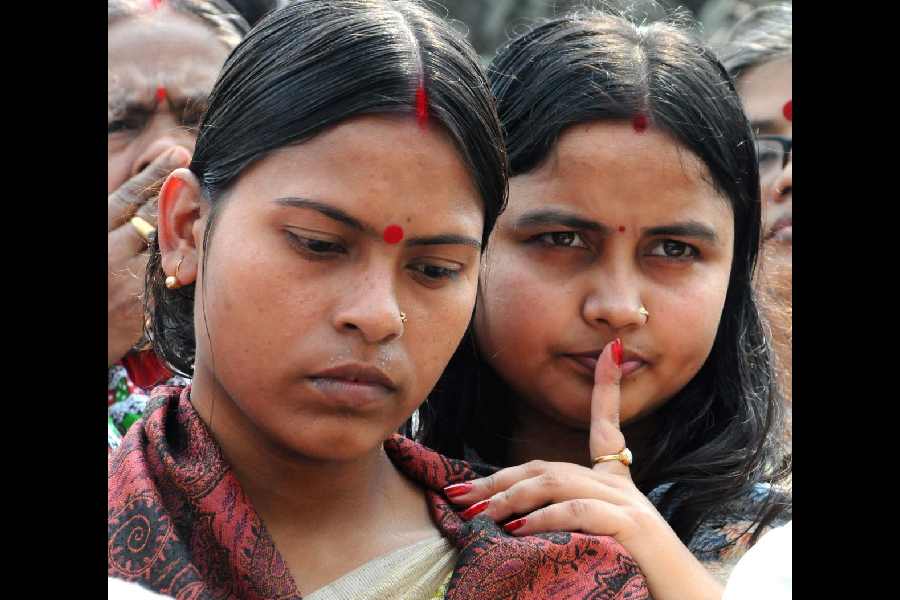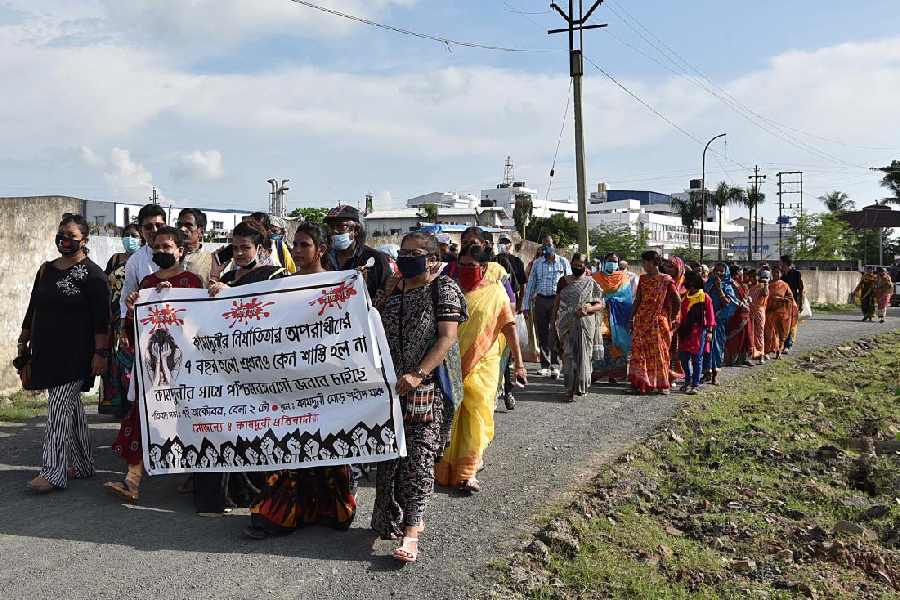A sign of the times greets you as you enter Kamduni in Bengal’s North 24-Parganas. It announces the promise of a snazzy upcoming real estate project just around the corner from the main road, from where a narrower road turns into the village itself.
This is very close to the spot where on June 7, 2013, a 19-year-old college student was grabbed by a group of men while she was on her way home, and raped and murdered.
The incident had the village erupting in anger and shook all of Bengal. The people of Kamduni, forgetting their political allegiances and other differences, united in grief and anger to demand justice for a girl being mourned like a daughter in every village household.
The anger led to the formation of the Kamduni Pratibadi Mancha, a protest platform. The college student’s family was part of it as also a large number of villagers. They would hold a meeting at Kamduni on the seventh of every month in memory of the girl. Among those who attended were human rights organisations and several political parties, except the ruling Trinamul.
The second sign of the times greets you at the main street corner of Kamduni. A small temple, the kind that fits into the side of a street, has just been built. It is a bare structure, yet to be painted. A villager says he does not know which idol will be installed. A small shraddha ceremony is in progress on the slope of a pond as you walk into the village, which used to be a Trinamul bastion at the time of the murder. Clumps of plastic packets and rubbish cling to the pond’s sides; a small group of men sits together staring dejectedly into the late winter afternoon.
Afew feet away is a two-storey building, the residence of Moushumi Koyal, one of the three remaining faces of the Kamduni protests. Tumpa Koyal, who was a friend of the murdered girl, and Pradip Kumar Mukherjee, the erstwhile headmaster of Kamduni Free Primary School, are the two other faces.
The Kamduni Pratibadi Mancha has been dismantled, as has been much else. Tumpa and Moushumi seem poised on the brink of a political career, with the BJP, though once they would take pains to assert that they and the movement were above party politics. Mukherjee, who had taught the murdered girl and her younger brother, says he would like to be remembered as a teacher instead of being identified by his political beliefs.

Mousumi Kayal and Tumpa Kayal
But Tumpa set the tone of the protests when chief minister Mamata Banerjee visited Kamduni 10 days after the murder in 2013. Villagers accused her of being late, and she in turn branded them “CPM supporters” and “Maobadis”. At the time, Tumpa, who lives with her husband and his family in another village, was visiting her parents in Kamduni. She raised her finger at Banerjee and asked her to listen to the villagers, an act of defiance that has perhaps not been repeated since.
On February 13, Moushumi, Tumpa and Mukherjee participated in a rally to protest the alleged atrocities by Trinamul activists against the women of Sandeshkhali, also in the North 24-Parganas. Sandeshkhali has been a flashpoint since the Enforcement Directorate attempted to conduct a raid on a Trinamul leader there this January. Though the BJP is trying to turn Sandeshkhali into an election issue, all parties and human rights activists were invited to the rally.
The Kamduni movement has come to reflect the political dynamics of contemporary Bengal. The ruling party has played its part in it. From the start, attempts were made to break down the protests systematically.
The murdered girl’s family members were given jobs not very long after
the incident. This created such resentment among other villagers that the family moved out of Kamduni and distanced themselves from the movement, though they returned eventually.
The younger brother now lives with the parents in Bahira Kalibari, not too far from Kamduni. The elder brother lives near them. Their house in Kamduni, a mud hut at one end of the village, lies collapsed. On the way to the house you see another sign of the times: a saffron flag hung in honour of the Ram Mandir inaugurated on January 22.
The murdered girl’s father’s family lives closely in a cluster of houses in this part of the village. A girl steps out of one of them. She is married to the father’s brother. The house has a cowshed and the family sells milk for their living.
She is remembered every day, says her aunt. She was the first girl from the family to go to college. “Her mother lost her mind almost after her death. She has never recovered,” she adds.
The villagers spoke of constant intimidation by local goons. Fisheries remain a major source of income locally. The villagers get a small percentage of the income, managed by local political leaders and their goons. “They stopped the payment from the fisheries. And threatened us all the time,” says Moushumi. “It is natural that fewer villagers began to attend our meetings,” she adds. Mukherjee cannot remember how many times he has been threatened by goons. He was transferred from Kamduni to another school.
The investigation and the prosecution by the government weakened the case further. The villagers had wanted the CBI as the investigating agency, but the CID was appointed instead. At the Barasat court where the case was first heard, when crowds of villagers would visit, the judge, pointing to the chargesheet that was filed ineptly had asked the investigating officer: “Is that a chargesheet?”
The protesters had maintained from the very start that the local political leaders were trying to protect Ansar Ali, the main culprit according to them, because he was a caretaker of the fisheries. The girl had been dragged into an enclosure from where Ansar Ali operated and her body, torn down till the navel and with severe wounds
all over, was found across the wall of the enclosure.
A Bankshall court verdict in the case in 2016 sentenced three of the accused, Ansar Ali, Saiful Ali and Amin Ali, to death and Bhola Naskar, Imanul Islam and Aminur Islam were given life imprisonment. Two were acquitted.
The sentenced moved Calcutta High Court. In 2023, before the verdict was delivered in October, the protesters, dwindled to a few, called a news conference to point out that 14 state panel advocates had either been changed or had refused appointments since the case moved to the high court.
The high court, based on evidence submitted by the prosecution, changed the death sentence of Ansar Ali and Saiful Ali to life sentences. Amin Ali was acquitted and the life sentences of three others were transmuted to lesser terms, which they had already served, and so they walked free.
The protesters, disappointed with the judgment, moved Supreme Court, for which legal help was organised by the BJP leader Suvendu Adhikari. Representing the protesters are prominent advocates Siddharth Luthra and Bansuri Swaraj, daughter of Sushma Swaraj, former external affairs minister in the BJP government at the Centre.
“We took the help that was available,” says Moushumi. The protesters have been to Delhi more than once since moving Supreme Court and are planning to go again. In a surprise development, the Bengal government has also petitioned the Supreme Court against the high court verdict.
The colours of a Bengal village are changing over the body of a dead girl.











